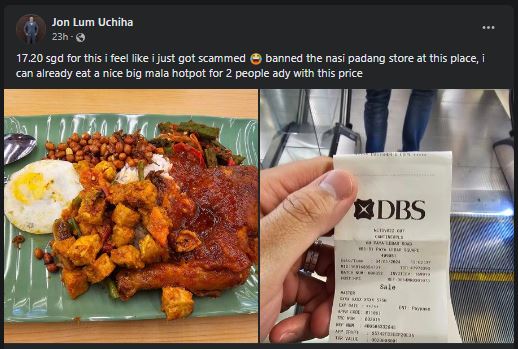Dining out is often an enjoyable experience, but what happens when the delight of a meal is overshadowed by an unexpectedly hefty bill? This is precisely what Facebook user Jon Lum Uchiha experienced when he bought nasi padang from a stall in Paya Lebar Square’s Cantine.
The Facebook Post
On January 4, Jon Lum Uchiha took to Facebook to share his dining misadventure. Purchasing nasi padang from a stall in Paya Lebar Square’s Cantine, he was taken aback when the cashier presented him with a bill totaling $17.20. The shock and disbelief prompted him to declare a ban on the nasi padang store at that location.
Accompanying his post was a photograph of the meal he had received, consisting of one egg, two vegetable dishes, a serving of peanuts with anchovies, rice, and a large chicken thigh. While the portion seemed substantial, Lum found himself questioning the value of his food compared to its price.
Analyzing the Cost Breakdown
In the comments section, Lum shed light on the breakdown of the costs, even though the receipt did not provide a detailed breakdown. According to him, the chicken was priced at $6.50, and an additional $2 was charged for the kacang (fried nuts). This revelation added to the diner’s frustration, as it seemed that the individual components of the meal were contributing to its unexpectedly high cost.
Lum, in his post, highlighted that with the same amount of money, he could have enjoyed a satisfying meal of mala hotpot for two. This brings us to the question of value for money in the context of dining out. How do consumers perceive the cost of their meals, and what factors contribute to this perception?
Consumer Reactions
The comments section on Lum’s Facebook post became a space for shared experiences and opinions from other diners. Some expressed solidarity, recounting their own encounters with unexpectedly high bills. Others questioned the restaurant’s pricing strategy, emphasizing the importance of transparency for customer trust.

